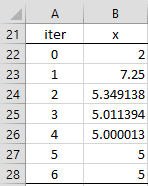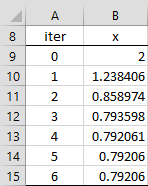Basic Concepts
Newton’s Method is traditionally used to find the roots of a non-linear equation.
Definition 1 (Newton’s Method): Let f(x) = 0 be an equation. Define xn recursively as follows:
![]()
Here f′(xn) refers to the derivative f(x) of at xn.
Property 1: Let xn be defined from f(x) as in Definition 1. As long as function f is well-behaved and the initial guess is suitable, then f(xn) ≈ 0 for sufficiently large n.
Newton’s method requires that f(x) has a derivative and that the derivative not be zero. Usually, the method converges quickly to a solution, but this can depend on the initial guess. Also in cases where there are multiple solutions, different initial guesses can lead to different solutions.
Click here for a description of the Real Statistics worksheet function NEWTON that implements Newton’s method.
Example (one unknown)
Example 1: Use Newton’s Method to find the square root of 25.
The problem is equivalent to solving the equation f(x) = 0 where f(x) = x2 – 25.
From calculus, f′(x) = 2x, and so
Suppose we start the iteration with x0 = 2, then as we see in Figure 1, the iterations converge to 5 as expected.
Figure 1 – Newton’s Method for Example 1
Note that if we select x0 = 0 the algorithm won’t converge to a solution since f(x) would be undefined. Also if we set x0 = -2 (or any negative value) then the procedure iterates to -5, which is the other solution to f(x) = 0.
Multivariate Version
We now extend Newton’s method to m equations in m unknowns.
Definition 2 (Newton’s Method): Let X = [xi] be an m × 1 column vector and let F = [fi] be an m × 1 column vector of functions. Our objective is to solve the set of m equations given by F(x) = Ο (here Ο is the zero vector).
Let J = [qij] be the Jacobian matrix, defined by the partial derivatives qij = . Now define the m × 1 column vectors Xn and the m × m matrices Jn as follows
![]()
Property 2: Using the terminology in Definition 2, then for a well-behaved F, a reasonable guess and sufficiently large n, F(Xn) ≈ Ο.
Click here for a description of the Real Statistics worksheet functions NEWTON2 and NEWTON3 that implement Newton’s method for two or three variables.
Example (two unknowns)
Example 2: Find the solution to the equations y – ex = 0 and x + y = 3.
Set f(x, y) = y – ex and g(x, y) = x + y – 3. Then we need to find the solution to f(x, y) = 0 and g(x, y) = 0 , i.e. F(X) = Ο where X = and F =
. Now
where we use the notation fx(x,y) to mean . Starting with X0 =
, we see in Figure 2 that the procedure converges to x = 0.79206 and y = 2.20794 after 3 iterations.
Figure 2 – Newton’s Method for Example 2
Representative formulas for the worksheet in Figure 2 (for iteration 2) are shown in Figure 3.
Figure 3 – Formulas for 2nd iteration
The example was chosen so that we could check the result using Newton’s method in one variable since the problem is equivalent to ex + x – 3 = 0 and y = 3 – x. We can therefore apply Newton’s method as in Example 1, with f(x) = ex + x – 3, f′(x) = ex + 1, and so
![]()
The iteration proceeds as in Figure 4.
Figure 4 – Alternative use of Newton’s Method for Example 2
Thus x = 0.79206 and y = 3 – x = 3 – 0.79206 = 2.20794, as before.
Examples Workbook
Click here to download the Excel workbook with the examples described on this webpage.
References
Wikipedia (2012) Newton’s method
https://en.wikipedia.org/wiki/Newton%27s_method
Wiersma, A. (2016) The complex dynamics of Newton’s method
https://fse.studenttheses.ub.rug.nl/14180/1/Alida_Wiersma_2016_WB.pdf




Charles,
There are typos in Ex 2.
Since y – e^x = 0 and x + y = 3, f(x) should be e^x+x-3 instead of e^x-x-3. Therefore, the subsequent derivative of f(x) and the recursive formula of the xn+1 should be corrected accordingly.
Thanks,
-Sun
Hello Sun,
Thanks for finding this error. I have now corrected the webpage. Fortunately the calculations were correct. although the formulas written were not.
Once again, I really appreciate your help in finding these errors.
Charles
Dear Charles,
Can you please, give the excel formulas for the iteration 0 in Figure 2?
Thank you.
c.
See https://real-statistics.com/logistic-regression/finding-logistic-regression-coefficients-using-newtons-method/logistic-regression-using-newtons-method-detailed/
Charles
how I can find more roots and number off roots
Raad,
If you use Newton’s method, you need to make multiple guesses as to the initial value. Different guesses can potentially yield different roots. If the degree of the polynomial is n (i.e. the highest power of a polynomial; e.g. the polynomial 3x^4 + 13x^2 – .4x + 1 has degree 4), then there are at most n real roots. In fact there are exactly n roots, although some of them may be complex numbers.
To find all the roots, see the following webpage:
https://real-statistics.com/other-mathematical-topics/roots-of-a-polynomial/
Charles